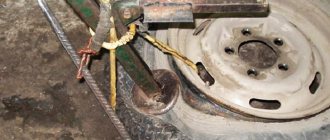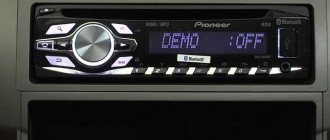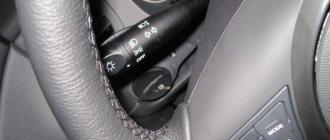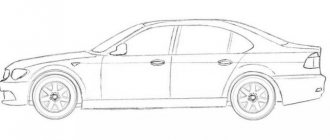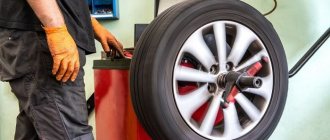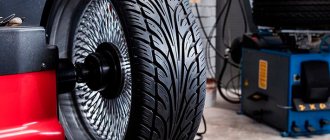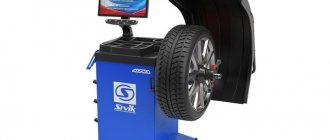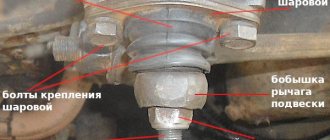Published:
25.04.2016
All drivers visit a service station several times every year, where tires are changed. There, specialists perform balancing and all necessary additional procedures on site. At the same time, most car owners do not know and do not think about the questions of what wheel balancing is, why this procedure is needed, how often it should be carried out, and also what the trip entails if there is an imbalance in the tires.
Wheel balancing must be done regularly for driving safety.
How to check wheel balancing yourself?
Do-it-yourself wheel balancing
Many car enthusiasts underestimate the importance of wheel balancing, considering such a popular event a waste of money. But this is a big mistake.
Such an attitude can lead not only to costs in the future, but also to a serious accident with unpredictable consequences.
Remember that timely wheel balancing is one of the main tasks for any driver. Moreover, we will look at how, when and why this is done in the article.
When it is necessary?
Experts identify several basic requirements regarding wheel balancing.
This work must be performed in the following cases:
- When replacing tires from winter to summer (and vice versa). Usually, at normal service stations, when “re-shoeing” a car, balancing is done immediately and is included in the cost of the service. If you change the tires yourself, you will also have to do the balancing work yourself;
- In case of hitting a curb, falling into a hole or passing a concrete policeman at speed. Such situations rarely end without a trace for the car's drive. Even a minimal defect can lead to wheel imbalance. Therefore, contacting a tire service is also mandatory;
- Every 15,000 kilometers. Few car enthusiasts cover such a distance within one year, so balancing when changing tires seasonally is sufficient. But there are also “truck drivers” who have to do this work twice a year;
- Every 7000-8000 kilometers – for those who like fast and aggressive driving;
- Before a long trip (1.5-2 thousand kilometers and above) and after it. This requirement is based on safety reasons.
What is the danger?
It would seem that what can happen if wheel balancing is not done in a timely manner? We often forget that each wheel has its own individual weight, pressure, technical characteristics, oval shape and defects. Therefore, the issue of balancing it is very important.
If this is not done, the consequences may be as follows.
- The braking distance of the car increases.
- This is easy to explain - the contact area between the tire and the asphalt decreases, grip deteriorates, and traffic safety decreases.
- Controllability decreases.
- The reasons are the same as in the previous case.
- There is a beating in the steering wheel.
- The imbalance in the wheel is transmitted to the suspension, and then to the steering wheel. The stronger it is, the greater the vibrations the driver feels. In this case, driving a car is very dangerous.
- Suspension wear accelerates.
- Poor balancing (or lack thereof) most affects the suspension bearings and hubs. Due to imbalance, these elements of the chassis system may even collapse. The result is loss of controllability and the likelihood of an accident.
- Increased tire wear.
The reasons are uneven distribution of forces and the appearance of vibration. Essentially, the tires will be “eaten up” on one side.
Types of imbalance
Today there are two main types of wheel imbalance:
Static imbalance. This implies an uneven distribution of the mass of the product along the axis; the wheel begins to “beat” in the vertical plane. In fact, there is no center of gravity on the wheel axle at all. This problem sooner or later leads to destruction of the suspension.
Dynamic imbalance is unevenness in the plane of the wheel. In this case, there is a center of gravity, and it is on the axis of rotation (where it should be). The only difference is that the axis of inertia and the center of gravity do not coincide.
The cause of the imbalance may be the design features of the wheel (tread pattern, location of the valve hole, inaccuracies in geometry, dimensions, and so on).
In this case, the greatest imbalance can be caused by the car tire itself. Here, a lot depends on the rubber material, weight, structure, and so on.
Signs of poor quality work
Wheel balancing is not always done well. There are several factors by which this can be determined:
The service station does not take any measurements before carrying out work. A good mechanic should definitely check the wheel and tire runout parameters. At the same time, it is advisable to do this as accurately as possible, taking into account radial and lateral runout;
All dirt from the tire and excess elements from the tread must be removed. If this is not done, then balancing becomes a completely useless exercise. Before starting work, the wheel must be perfectly cleaned;
Pay attention to the appearance of the balancing machine. If it is dirty, then it is very difficult to count on accurate data and high-quality balancing.
Final balancing
Final balancing is performed on wheels that are already installed on the car. The advantage of the work is that not only the wheels are adjusted, but also the brake discs, CV joints, hubs and axle shafts.
This type of balancing ensures a real smooth ride, improves wheel grip and allows you to achieve a number of other positive aspects.
We do the work with our own hands
To perform balancing, you need to prepare a special set of weights (you can buy it in the store).
At the same time, for cast and forged wheels, balancers are sold that are glued to the wheel (they should be given preference).
The sequence of actions is as follows.
- Raise the wheel with a jack and make sure it rotates easily. If there is friction, loosen the hub nut slightly. Clean the wheel from dirt and remove all stones from the tread (they will interfere with balancing).
- Be sure to check the tire pressure. It must be in accordance with the recommendations specified in the car's operating manual.
- Remove the old balance weights.
- After this, spin the wheel counterclockwise and wait until it stops completely. Now you can mark the top point with chalk (this is the easiest place).
- Next, rotate the wheel clockwise and place the mark again (also at the top point). Between the first and second mark is the lightest part of the wheel.
- Glue balancers weighing 30 grams on both sides.
But that is not all.
We spin the wheel in any direction and see that after it stops, the weights should be at the bottom. With this we found out the point of necessary balancing. If the result is different, select heavier weights, but do not overdo it.
Having achieved the result, move the weights to the right or left from the last point. It is necessary to ensure that the wheel stops at different positions of the point.
Now move on to the rest of the wheels and proceed in the same sequence.
But to balance the rear wheels, it is recommended to put them in place of the front ones, although not everyone does this.
How do professionals work?
In professional workshops, wheel balancing is performed on special computer-controlled machines. Human participation in such work is minimal.
Laser equipment accurately determines the installation location and weight of the required balancers. In this case, all data is displayed on the monitor screen.
This balancing allows you to eliminate any type of runout of the wheel and disk assembly.
Conclusion
Remember that wheels need periodic balancing, and the technical condition of the vehicle and your health directly depend on this.
How to correctly determine wheel imbalance?
First of all, it is necessary to take into account that imbalance can appear not only in the static position of the wheel, but also in dynamics. In both the first and second cases, the lack of balance causes a mismatch of inertia and rotation axes. Next, we will consider two types of imbalance separately:
- Static imbalance : appears if the axis of inertia is parallel to the existing axis of rotation; there is no center of gravity on the axis of rotation. This suggests that the weight of the wheel is not evenly distributed along the circumference. In order to check for static lack of balance, you need to put the wheel on an axle that rotates freely, carefully rotate it and pay attention to the fact that after a couple of pendulum movements it will completely stop. And in that case. The center of gravity of a car wheel is located at the lowest point.
- Dynamic imbalance : only appears when the weight of the wheel is unevenly distributed across its width. From this it follows that to determine the imbalance it is necessary to use rotation at high speed.
You should also know that static imbalance cannot be eliminated using weights in ordinary tire shops. Since in such tire fittings only dynamic imbalance can be eliminated.
Is there an optimal imbalance?
Under normal conditions, it is impossible to achieve ideal distribution of centrifugal force and ideal wheel balancing. But maximum permissible standards still exist.
It is necessary to pay attention to the fact that if the maximum permissible imbalance is exceeded, with optimal disk geometry, the tires can be considered defective. It’s not that they can be, they just need to be replaced under warranty at the store where they were purchased, or simply returned to the tire seller and get all your money back. But before making claims, it is necessary to take into account that the quality of any measurements is significantly influenced by several important factors. This is, first of all, the presence of pieces of dirt on the disk itself; they, in turn, also have their own weight and can significantly distort the instrument readings.
In addition, it is generally accepted that in order to obtain a more accurate result, it is necessary to measure the geometry of the wheels and tires separately. This is true if balancing is carried out on old equipment. Modern tire fitting systems operate using laser technology, which makes it possible to carry out various measurements without removing the tire from the rim.
It is also recommended to pay attention to the tools and equipment around you. Everything must be neat and clean and in working order. The balancing machine must be installed on a concrete pad and fixed very securely, otherwise all its readings are not serious, and you will simply pay money.
The paws of the machine, which is designed for beading tires, must be equipped with special plastic linings, which make it possible to avoid scratches on the rims. A set of tools must necessarily solve all problems that may arise that may be associated with the implementation of the main stages of work. It is also recommended to ask the craftsmen a question about the last time the balancing machine and pressure gauges underwent a special check; there should be documents that can confirm this. This is quite important, and therefore the owners of modern tire centers do this regularly.
What is wheel balancing
Wheel balancing is the work of evenly aligning the weight of the wheel relative to the center of the wheel. Those who rode Soviet bicycles know that when you hit a hole at speed, the rim of the disk becomes bent, then the wheel begins to wobble, because the shape has been changed and the center of gravity of the wheel is also shifted. The required procedure for setting the optimal location of the wheel mass is due to wear of suspension parts, replacement of ball joints and other parts.
As we know, it happens that tire wear is uneven; the treads on one wheel wear out faster, and only on one side, the inner or outer. This indicates that a wheel alignment needs to be done. But it could also be due to wheel imbalance. Correctly done wheel balancing eliminates rubber eating. In addition to rubber wear, properly done balancing eliminates steering wheel vibration and increases the life of bearings, ball joints and other suspension parts.
Pros of wheel balancing:
- no steering wheel beating;
- comfortable ride, when you release the steering wheel the car does not pull to the sides;
- saving rubber;
- Tire wear is even.
All passenger cars, regardless of the make and model of the car, require wheel balancing. During vehicle maintenance, balancing is not checked.
What happens if you don't balance:
- hub bearings are subject to radial runout, which means they wear out and jam faster;
- vibration and beating of the steering wheel at any speed;
- rapid and uneven tire wear;
- noise in the car interior;
- reduction of shock absorber service life;
- the dynamics of the car are disrupted because the centrifugal forces of each wheel pull at random;
- The ball joint may break off.
Errors when balancing wheels
So, you discovered signs of an unbalanced wheel and went to a tire shop. How to determine that a master is doing his job poorly?
- The specialist did not wash the tires and wheels . Most often, an unscrupulous technician does not wash car wheels. At first glance, it may seem that this procedure is not that important. But if there is dirt on the tires and rims, they will not be balanced. After all, even a ten-gram piece of dirt on a wheel, or a small pebble that gets stuck in the tire tread, can cause imbalance. And when you drive at a speed of 100 kilometers per hour, the steering wheel will begin to hit, and the suspension elements will begin to experience an unintended load, ultimately leading to destruction.
- The balancing machine is not securely fastened.
Another reason why a wheel may become unbalanced is that the balancing machine is not positioned correctly. They can simply put it in a trailer on a wooden surface. But such a machine must be attached with anchor bolts to a flat concrete floor. There should be no vibrations. Otherwise, the master will not be able to perform balancing efficiently. You should not visit mobile tire shops, because there will be no benefit from such balancing. - The technician did not calibrate the balancing machine .
According to the rules, balancing equipment must be calibrated several times a season. However, in many tire shops, whose owners are not concerned about the quality of the services provided, this procedure is not carried out. In addition, it is impossible to calibrate an expensive machine on your own. In order not to waste money on the work of a third-party specialist, sometimes calibration is not carried out. - The master glued the balancing weight poorly.
If the rims are alloy, then the balancing weights are usually glued on. To prevent it from coming off due to vibrations or moisture during car washing, it is necessary to properly prepare both the weight and the disk. Before gluing the weight, you need to wipe the disk with a degreasing compound, such as solvent. Moreover, the disk must be cleaned of dirt in advance. The area where the weight will be glued, and the weight itself, are heated with a construction hairdryer.We recommend
“Final balancing of wheels: a marketing ploy or a useful procedure” Read more
This is the correct operating technology; if it is followed, the weight will never come off, even if water gets on the wheel at a car wash. But, unfortunately, the technology of the procedure is often violated, so at car wash stations you can see a lot of weights that have come unstuck. - The master does not perform balancing “at zero”.
The specialist is in a hurry or lazy, he tells you that nothing bad will happen, even if there is 5 g of imbalance. But when the disc is mounted on the car, signs of imbalance will appear. That is why it is important that after balancing, zero deviation indicators of balance indicators outside and inside the wheel are displayed on the bench monitor.To achieve this result, you will have to peel and re-stick the weights several times. Maybe the technician will even disassemble and clean the inside of the wheel if there is any water or dirt left there. Or the disk is bent, in which case it needs to be straightened. In any case, there should be no errors. Even a minimal imbalance of 5 g will cause the steering wheel to wobble at high speed, the car will handle worse, and the suspension elements will quickly fail.
- The master uses a wrench to tighten the wheel..
Working with a wrench, the technician spends less time and effort, but driving a car after such a service becomes unsafe. The fact is that a wrench can ruin the threads on studs, nuts and bolts. As a result, there is a threat to the lives of the driver and passengers. If the technician over-tightens the nuts and bolts, the wheel seat will become distorted and you will again experience signs of an unbalanced wheel.Even though the technician can use the impact wrench carefully, the bolt or nut will still be overtightened. And when you want to unscrew the wheel on the track, you will not be able to do it. Only the newest tire centers use special impact wrenches, which can be used to make the force minimal. At the end of the work, the master uses a torque wrench to tighten the nuts to the required torque. Remember that you can use a wrench to unscrew, not tighten, nuts.
- The specialist tightens the bolts or nuts on the disk in a circle .
In this case, the alignment of the car wheel relative to the hub will be disrupted. As a result, signs of an unbalanced wheel will again appear. The hub, as well as the suspension elements, will experience increased loads. How not to lose alignment? To do this, tighten the nuts and bolts crosswise. - The technician does not use a torque wrench and tightens the nuts incorrectly, with too much force..
It often happens that when installing a wheel, the master tightens the nuts, focusing on his feelings and experience. Or uses a wrench. Since the disc material is quite soft, due to the fact that the nuts are unevenly tightened, they become crooked and signs of imbalance appear. How to tighten bolts and nuts on a wheel? A torque wrench is used to perform this procedure. With its help, you can tighten it with the required force, which differs depending on the make and model of the car. You can find out what the force should be for your car in the vehicle’s operating instructions.It is worth noting that the standard wheel key, which is located in the luggage compartment of your car, has such dimensions for a reason. The size of the wrench should be such that, by kneeling and pressing with your hands (without attaching a pipe to the wrench or pressing on it with all your might), you can tighten the nuts on the wheel with the required force. It does not matter whether a man or a woman performs this procedure.
You should be able to unscrew the wheel just as easily with a standard wheel wrench. Of course, if at the tire fitting the specialist used a torque wrench and did not tighten the nuts.
Why is wheel balancing done?
Although there are many negative consequences if balancing is not done, many still refuse to balance disks.
What is the load on the suspension?
We used size 14 car wheels as the basis. We took the speed to 80 km/h. The violation of the center of gravity of the wheel was only 20 grams, that is, the rim of the disk is bent and the centrifugal forces are distributed unevenly during rotation. In this case, the impact on the suspension is comparable to a blow with a sledgehammer with a force of 3 kilograms. In a minute, the R14 wheel rotates about 800 times when driving 80 km/h. So it turns out that within an hour of driving, an invisible sledgehammer will tap on the suspension.
Types of imbalance
Imbalance is an imbalance, that is, the load perceived by a part is different. Due to the imbalance, the car's suspension begins to crumble.
Wheel balance is when the center of gravity of the wheel lies on the wheel axis. The axes of inertia must be parallel. If the wheel or wheels are unbalanced, the driver immediately feels that the car is being pulled to the side and the steering wheel is vibrating.
Types of imbalance:
- Static. Less common. The center of gravity is shifted to one side.
- Dynamic. It occurs more often on wheels with wide tires. Already at a speed of 40 km/h the car is driving in different directions.
- Combined. This is the main type that happens to the wheels of modern cars. To eliminate the imbalance of conventional stamped discs, a conventional balancing machine is used. Balancing alloy wheels requires more expensive equipment using laser techniques.
Instructions for calibrating a balancing machine yourself
For accurate calibration, you need a reference wheel or a special rotor that is known to have the correct geometry.
1. First you need to fix the reference disk using a nut and a cone. After making sure that everything is securely fastened, you can proceed to the measuring procedures. After the disk spins, the indicators are compared with the reference horizontal and radial values.
2. Enter the width, diameter and distance parameters on the control panel.
3. For calibration, weights of 50-100 grams are used, and the process itself may differ slightly depending on the brand of equipment.
4. First, you need to run the first self-calibration cycle on the machine and then attach a 100 g weight to the outside of the rim.
5. Then you need to run another cycle, but without the weight.
6. If after calibration the balancing stand still shows an error of 5-15 grams, then you need to do the following: balance the wheel, rotate it 90 degrees and check the readings again. If they have changed, then it is necessary to check the cone, on which uneven walls could appear.
7. Separately, you need to check whether the electronic ruler is working properly. To do this, all parameters must be entered into the system manually, and then compared with the automatic determination.
Source
Balancing technology
When carrying out this type of work to eliminate a shift in the center of gravity, you need the appropriate equipment to know the errors that may occur.
Equipment
As with any preparatory work before repair, we clean the parts. Be sure to clean the rubber from dirt. Dirt packed into tread patterns can affect the diagnosis of a wheel center of gravity shift.
If the wheels have already been balanced, you must first remove the balancing weights.
Tire pressure should be normal. If the tires are flat, this will greatly affect the diagnosis.
On a machine for balancing passenger car wheels, the center of gravity is first measured. Machines are different. There are expensive, computerized ones with laser sensors. After the machine has determined where the center of gravity of the wheel is, it itself shows in which part the balancing weight should be installed.
Depending on the disc material, different weights are also used. Weights with brackets are installed on steel disks. They are attached to the disc rim with a bracket.
And, if the disks are cast, then weights are used with landing on the inside. Sinker material: lead, zinc, steel.
The weight of staple weights ranges from 5-100 grams. The weight of casting weights is 5-60 grams.
On stamped rims, a weight is driven onto the edge of the rim between the disc and the rubber. These padded weights are not suitable for alloy wheels.
Velcro weights are used for them - self-adhesive weights. They are more difficult to secure because they are placed on perfectly flat surfaces.
Balancing procedure
The procedure is not complicated:
- Remove the wheel.
- Clear.
- Install it on a machine that will determine the displacement of the center of gravity and determine how much mass the weight should be attached to in what place.
- I ran it again on the machine and made sure that the center of mass coincided with the axis of the wheel.
- If the machine shows balance, then put the wheel in place and check the following.
What errors can occur during balancing?
- The imbalance cannot be determined unless the tire is cleared of stones and dirt.
- Installing new weights without removing old ones.
Safety precautions
- Persons over 18 years of age, healthy and having knowledge of how to operate the machine are allowed to work at the machine.
- Wheels that are too heavy, such as those from Jeeps, should be transported on a dolly. Many people are ashamed, like: “Why, I’ll still be embarrassed now,” then by the age of 25 they already have a back that has been torn several times. Some people are even ashamed to lift a 50 kg bag of cement with two people. So one person carried one and earned himself a hernia. And what is all this asking for?!
- The specialist must be sober. If you see that he is drunk, you should go to another car service center.
How to check wheel balance
You can check it yourself. If you feel that on a flat road, when you release the steering wheel, the car immediately throws to the side, or you feel that the steering wheel vibrates with a certain frequency, then this is a sign of imbalance.
Place the car on a jack. Draw a transverse line on the rubber with chalk. Spin the suspended wheel. A bent wheel, a figure eight, you can see right away.
Do the rear wheels need to be balanced?
Many people think that only the front wheels need to be balanced. But no. If the rear wheels are “eight”, then they also need to be put in order.
How long does it take to balance wheels?
If you follow the instructions, you need to balance the wheels every 5,000 kilometers. This is if no repair work has been carried out.
- If the tires have been changed, then the wheels are checked and, if necessary, balanced.
- If there is any wobble in the steering wheel, then they do it.
- If you notice that you have driven into a hole at high speed or crashed into a curb, then you need to do it.
Balanced wheels extend the life of the entire vehicle, namely the suspension parts.
Bench wheel balancing process
It is impossible to independently find where exactly the wheel has the “center of the problem.” Correct balancing should be done by specialized specialists who have high-quality modern equipment and know how to do it correctly. The video below shows in detail the wheel balancing process.
The balancing process includes several stages, including preparatory ones, and compliance with them is important for a high-quality final result:
- Cleaning the wheel. The tread, side part, and wheel rim are thoroughly washed so that there is no adhering dirt or stuck small pebbles. Even little things like this are important for balancing;
Cleaning wheels and tires from dirt - Removing weights from previous balancing. Only the wheel itself is corrected, and not the excess weight attached to it;
Removing the old load - Checking the pressure and inflating the tires (if necessary), the wheel is balanced in a normally inflated state;
- The wheel is then mounted on a stand to determine the center of gravity. Using the equipment, deviations during its rotation are recorded and the heaviest points are determined;
Let's start the wheel spinning - To compensate for heavy areas, weights of the appropriate weight are installed on the opposite side. With dynamic imbalance, weights are placed on the outer and inner sides of the wheel rim, with static imbalance - only on one side, opposite the heavy point;
We glue new weights
We look at the imbalance indicators - Weights are made of lead, zinc or steel, and in most cases the material does not matter.
Methods for installing weights differ for different disks: steel weights are placed with a bracket, cast weights are installed on the inner surface, stamped ones are stuffed (stuffed into the gap between the disk surface and the tire), and light alloys are self-adhesive.
The latter are the easiest to install and at the same time the most unreliable: they can fall off due to temperature changes, humidity and vibration.
Typically, if a wheel requires a lot of weight to balance, it means there is something wrong with the wheel: a warped rim, debris stuck in the tread, etc. In this case, the technician additionally inspects the wheel for deformations and traces of impact.
Each wheel is balanced separately in turn. Contrary to the opinion of very “frugal” car enthusiasts, you cannot balance only the front wheels and leave the rear ones as is. All elements of the chassis and suspension must be normal.
Do-it-yourself wheel balancing
Wheel balancing is one of the measures that ensures vehicle stability on the road and affects traffic safety. Many car owners believe that high-quality balancing can only be done by service station specialists. They are partly right, but it is not always possible to turn to specialists, and you cannot delay the procedure. In this situation, you can balance the wheels yourself in a garage. There are ways to carry out this procedure without professional equipment.
Why balancing is needed
Uneven tire wear or damage to the disc leads to imbalance, that is, an imbalance in the distribution of wheel mass relative to the horizontal and vertical planes. There are two types of imbalance:
- Static, when the axis of rotation shifts relative to the axis of inertia and begins to move the center of gravity up and down.
- Dynamic, when the axis of rotation intersects with the axis of inertia, disrupting the horizontal distribution of the wheel mass. The disk makes a figure eight while the car is moving.
There are two types of imbalance: static and dynamic
Imbalance causes the wheels to vibrate while driving. Wheel imbalance, especially when driving at high speed, worsens handling, increases the braking distance, and leads to premature wear of chassis parts.
Unbalanced wheels cause loss of control when driving at high speed. But even if an accident does not happen, constant vibration causes the hub bearing to become unusable, and over time, the entire chassis system of the vehicle breaks down.
The purpose of the procedure is to restore balance to the wheels during rotation. The result of balancing is a uniform distribution of wheel mass relative to the axes of rotation.
What is balancing and why is it needed?
Balancing is the centering of the mass of a wheel relative to its geometric axis, which reduces vibration during movement.
What does wheel balancing affect? The importance of this procedure cannot be underestimated, because not only the comfort of driving a car, but also the longevity of the suspension, tires, and steering column of the car depend on its timely implementation. After all, an imbalance of just 20 grams on a regular 14-inch tire when driving at a speed of 90–100 km/h is equivalent to hitting a sledgehammer weighing 3 kg with a frequency of up to 800 times per minute. In addition, if the wheels are not balanced, when driving at high speeds, the safety of the trip decreases, since vibration increases with increasing speed.
How often to carry out
There are no clear and specific recommendations for all cars on the frequency of balancing. It all depends on the operating conditions of the vehicle, the condition of the wheels, and other factors. Experts recommend balancing:
- While changing tires. In reputable service stations, the procedure is included in the price of the car.
- If the wheel hits an object or falls into a hole. Such situations lead to disc damage and wheel imbalance.
- After 15,000 km. During the season, few car enthusiasts accumulate such a number of kilometers, so a standard car only needs balancing when changing tires.
- Every 8,000 km for lovers of an aggressive driving style.
- Before traveling over 1500 km.
When do you need to balance your wheels?
Speaking about the frequency of such a procedure, it should be noted that not even an experienced service station employee will answer the question of how often this should be done on your car. And all because it is very individual, it depends on driving style, frequency of tire changes and many other factors. But to the questions whether you need to balance your wheels every season and whether you need balancing when changing wheels, you will receive a clear positive answer.
However, for some reason, many car owners ignore the recommendations of a car mechanic. It is a mistaken belief that only new wheels or after beading should be balanced. But if they were balanced last season, then removed for the season and simply stored somewhere in the garage, then they can be installed for the next season and driven like that. They forget that balancing is needed both after storage and after a certain mileage.
If we talk about certain rules, then you need to balance after installing the tire on the rim, and then after 500 km. After all, no matter how well your wheel is made, shrinkage will still occur at first, the tire will fall into place, shifting somewhere and causing an imbalance.
In addition, manufacturers recommend carrying it out periodically, at least every 15 thousand kilometers, and on our roads it can be done more often. It is also worth visiting a service station after falling into a large hole, before and after a long trip (from 2,000 km). This procedure will not hurt fans of extreme driving; it is recommended for them to do it at least every 7 thousand km.
Signs of Imbalance
The main signal of imbalance is the appearance of vibration. The intensity of vibration transmitted into the cabin depends on the degree of imbalance. Sometimes at speed the car begins to literally tremble with its entire body.
The nature of the vibration indicates which wheels are unbalanced:
- the front ones give shock to the steering wheel;
- the rear ones make the rear seats vibrate.
Other signs of imbalance include increased fuel consumption, tire noise when driving, uneven tire wear, and regular flat tires.
Balancing methods
Various manufacturers offer devices for passenger cars or a truck balancing machine. But it is less in demand in the city, since most of the cars serviced are passenger cars. Therefore, malfunctions are more common with them.
Before choosing a Hofmann balancing machine or purchasing Storm LS 11, Civic, Beissbarth, AE T, Sivik Galaxy, Patriot devices, you should find out what balancing methods can be used on the machines.
- Adjustment nut. The special quick-release and quick-release nut is in great demand. This type allows you to quickly detect and eliminate faults. A quick-release nut requires drilling a hole in the part into which the nut is screwed. The quick-release nut has an important advantage - it is quick-release. Due to this, the quick-release nut can be easily changed and quickly moved from place to place.
- Drilling. The method is not as effective as the quick-tightening nut, but it is the simplest, and therefore popular when working with your own hands to troubleshoot cars. Like a quick-release nut, this requires drilling a groove and making a hole in problem areas of wheels, shafts, etc. Due to the grooves and holes, weight is reduced. If a quick-release nut can reduce and increase mass, then simple drilling with your own hands only means reduction.
- Rings. This type of balancing is not relevant for cars, like a quick-release nut. This type is used in the metalworking industry. Wheels can be used to repair milling equipment.
Source
Balancing methods
Using the advice of experienced drivers, you can carry out balancing yourself the old fashioned way without using a special machine. This will take more time than a service technician would spend, but it will help save money.
If desired, wheel balancing can be done independently in a garage.
To perform the procedure yourself, you will need the following equipment and materials:
- jack;
- balancing weights;
- chalk or marker;
- a set of keys.
Interesting! To balance wheels on cast or forged wheels, it is advisable to purchase self-adhesive weights. But in winter, such weights can come unstuck due to temperature changes.
Balancing weights are required for balancing
Without removing the wheel
The self-balancing process consists of the following steps:
- Preparatory. The wheels are cleaned of dirt and stones stuck in the tires, the caps are removed, the pressure in the tire is reduced, and old weights are removed. The jack is installed on one side of the vehicle, freeing 2 wheels. Check the free rotation of the wheels. If the wheel is difficult to spin, you need to undo the cotter pin and loosen the hub nut.
- Determination of an easy point. The wheel is turned counterclockwise and waited for it to stop. Mark the top point. Then turn the wheels clockwise and mark the top point again. The midpoint between the two marks is the light point.
- Installation of weights. Using a hammer, weights weighing from 10 to 45 grams are placed on the found point, starting with the light ones. After this, they spin the wheel and wait for it to stop. The weights should be at the bottom. If it turns out wrong, the light weights are removed and heavier ones are added. It is not recommended to use more than 60 grams of weight on one wheel.
- Static balancing. As soon as the weights are at the bottom after stopping, they begin to move them apart in different directions. The wheel begins to rotate and the weights move apart. The goal of the process is to ensure that the wheel stops in a different position each time. Once this starts to happen, the weight is distributed evenly, that is, static balance is achieved.
The procedure is carried out in this sequence with each wheel. To check the correctness of the balancing, you need to drive the car at least ten kilometers at a speed of more than 90 km/h. If you don’t feel any jolts or tapping while moving, it means everything was done correctly. If the procedure is performed incorrectly, specific shocks to the steering wheel appear.
For your own confidence, at the first self-performed balancing, you can undergo diagnostics at a service station. If the specialists confirm that everything was done correctly, in the future you can carry out the procedure yourself.
Important! Self-balancing in the garage is only permissible if there is a static imbalance. Eliminating dynamic imbalance requires the use of equipment. Experts recommend contacting a service center if your car has worn tires and old bent wheels. Without special equipment, it is impossible to balance such wheels yourself.
At a homemade stand
You can make the balancing process easier by making a homemade stand in the garage. In this case, you do not have to remove the brake pads from the wheel and loosen the step nut.
A homemade stand simplifies the process of wheel balancing
The stand is mounted from an old hub with a working bearing. The hub is installed on the frame so that the wheel rotates freely and the entire structure is firmly held on the surface. It is convenient to use vertical metal posts as a frame, between which the wheel is attached. Further balancing actions coincide with the previous method of performing the procedure.
On the machine
Even an experienced motorist in a garage carries out balancing “by eye”. Therefore, there can be no complete confidence in the correctness of the process. In specialized workshops, balancing is performed on computer-controlled machines.
Modern service stations are equipped with CNC balancing machines
The machine consists of a cone-shaped support for mounting a wheel, a rotating electric motor and sensors. The wheel rotates when performing tire mounting, and at the same time the computer detects vibration and pressure. Sensor readings help to accurately calculate the weight and location of weights.
The workshops are equipped with two types of machines:
- Manual - in which the master measures the wheel with a ruler and manually enters the data.
- Automatic - information is read by sensors and displayed on the monitor in digital or graphical form.
Based on the type of supports used, machines are divided into:
- Soft, measuring wheel parameters, taking into account the vibrations of the supports.
- Rigid, measuring pressure and rotor phase.
Interesting! On rigid machines you can test various parts, but the quality and accuracy of measurements is reduced for this reason.
Most modern services are equipped with automatic balancing machines. The master puts the wheel on the shaft, tightens it with bolts and unscrews it. Sensors determine the points of axial runout. The computer determines the intensity of the push and calculates the mass of the load that must be attached to the calculated point. The computer will also inform you if the wheel cannot be balanced.
When balancing is not possible
There are situations when the correct wheel balance, even if all recommendations for the procedure are followed, cannot be established. This can happen for the following reasons:
- A foreign object has entered the wheel. For example, there is a screw or nut between the disk and the tire. In this case, re-flashing the wheel solves the problem.
- Poor quality tire. If the layers of rubber on a tire are not applied evenly, balance will not be achieved. The tire will have to be replaced or the wheel assembly will need to be spot balanced using professional equipment.
- The wheel rim is deformed. Most often, stamped discs have non-ideal geometry. Especially Russian-made ones. The problem is solved by rolling or replacing the disc.
The total weight of weights installed on a new wheel should not exceed 60 grams. If to achieve balance you have to install weights weighing more than 60 grams, it is worth checking the correct assembly of the wheel, the geometry of the disk and the quality of the tire.
An additional check for correct wheel balancing is carried out while driving. If at a speed of 90-100 mph you do not feel tapping, jolts on the steering wheel or vibration, then all actions have been performed correctly. To confirm the results of the work, it is advisable for a beginner to undergo diagnostics at a service station. If the experts determine that the wheels are in balance, you can safely carry out the procedure yourself in the future.
Errors during the procedure
If the balancing process is carried out in violation of the technology, then the vibration problem, at best, will not be solved, and at worst, it will further worsen. The most common mistakes:
- Balancing when there is dirt on the wheel. Even pebbles stuck in the tread can be disrupted by additional imbalance. The overall picture, even with precise equipment, will be disrupted, and it will not be possible to bring the wheel to zero.
- Balancing a wheel with a broken tire or wheel geometry. If the disc has even minor dents or distortions, it must first be rolled on a special machine. Straightening the disc with a hammer or other impact instruments is unacceptable.
- Incorrect torque of the hub bolt on the balancing machine. Excessive force will lead to the wheel being misaligned and the balancing will be incorrect.
- Violation of technology for installing a tire on a disk. Often, even experienced installers perform work in violation of technology. As a result, the wheel is given additional inertia.
- Misalignment during installation of the wheel on the vehicle axle. This problem occurs due to incorrect tightening of the bolts. Even if a properly balanced wheel is installed skewed, it will vibrate.
In order to avoid such troubles, you need to carefully choose a car service and supervise the work of the technicians. Qualified specialists guarantee their work and show the balancing results on the machine display. If the master prohibits the presence of the car owner during work or does not provide a guarantee, it is advisable to refuse his services.
Wheel balancing is an important element of monitoring the technical condition of a vehicle. A timely procedure will help not only improve safety and driving comfort, but also extend the life of the vehicle by preventing premature wear of chassis parts.
How is wheel balancing done?
Before you begin balancing, the wheel should be prepared. First, it is thoroughly cleaned, all old weights are removed, washed, and dried. Check that the tire is installed correctly. The wheel should be slightly lowered, the air pressure in it should not exceed 0.2–0.3 kgf/cm2.
At tire shops, balancing is carried out using special balancing stands or machines. But you can try to eliminate the imbalance at home without a stand, however, the accuracy of such a procedure will be much lower.
In order to eliminate the imbalance at home, you need to lift the car using a jack so that the wheel rotates freely. First it spins to the right. After stopping, a chalk mark is placed at the highest point. Then it spins to the left, the procedure is repeated. The distance between the marks must be divided in half and a new mark must be placed. After this, special weights with spring clamps are installed on both sides of the mark on the tires for balancing, which are mounted under the tire, while the weights are held on the wheel rim. Then the wheel is spun again by hand. If after stopping the weight occupies the lower position, then everything is fine, its weight is sufficient. If it ends up at the top, then you should replace it with a heavier one. By moving the weights to the same distance from the mark, it is necessary to ensure that after unwinding, each time the tire stops in a new position, chaotically. If this can be done, then the wheel is pumped up and you can start balancing the other one. The imbalance on the front wheels is corrected at their hubs. But the rear ones should be unscrewed and moved to one of the front hubs for balancing.
At service stations and tire shops, this procedure is carried out using special equipment. After all the preparatory procedures, the wheel is installed on a balancing machine with a fastening cone.
Correct wheel balancing, the most accurate, is done on a special computer stand. A wheel is installed on it and its parameters are set. After that, spinning it in different directions, using a computer, the lightest place and the missing weight are revealed. The car service specialist simply adds weights to the disc in the required places to eliminate the imbalance.
It is worth considering that the total weight of the installed weights should not exceed 60 grams. If their total weight is higher, it is worth thinking about whether the wheel is assembled correctly, whether the disk is deformed, or whether the tire is stale. If the tire is just from the store, and is installed correctly, there is no damage to the disk, then the need to attach weights with a total weight of more than 60 grams. indicates her marriage and may serve as a reason to return to the store.
After the usual, some tire centers perform final wheel balancing. It is carried out after installing the tire on the car, since here the imbalance of the wheel is checked and eliminated simultaneously with the hub and brake disc. To do this, the wheel is spun and by using a final balancing device, the imbalance of the entire assembly is revealed. It is leveled using the same weights. Moreover, their weight should not be more than 15 grams. It is important to understand that this is not an alternative to computer stands or machines, it is simply a way to improve the quality of balancing.
What it is
This is the name given to the procedure for balancing wheels so that they rotate in the desired projection and do not hit while driving. Balancing is also done at home, but this is rarely done due to a lack of knowledge, experience and technical devices. The operation organically distributes the weight of the wheels, ensuring optimal rotation. There are 2 types of imbalance:
- Static type. The parallel arrangement of the inertial and rotating axles leads to displacement, runout and non-uniform distribution of the wheel mass along the length.
- Dynamic type. Here the inertial and rotating axis do not coincide, forming an angular intersection. As a result, the mass is unevenly distributed across the width.
Balancing is performed frequently. It is best to carry it out at a service station or tire shop where the necessary equipment is available.
A specialist will carry out balancing quickly and efficiently
How to balance wheels in a tire shop
Specialists center the wheels by hanging prepared weights on the rims. The quality of the equipment and the qualifications of the employee are decisive. To avoid inaccuracies, the machines on which alignment is measured are regularly calibrated, carefully maintained and checked. Both static and dynamic imbalances are eliminated on the equipment. It happens that they are present together on wheels.
In some cases, when exceptional accuracy is required, the car is suspended on a stand, and the measurements are made by a computer. At the moment the wheel spins to a certain speed, it indicates the area where the load needs to be suspended.
Trucks and buses are automatically balanced by pouring granular mass inside. As the tire moves, the granules stick to the inside of the tire, distributing the weight evenly and ensuring precise movement along the trajectory.
Balancing is a popular service at any tire shop.
How to balance a wheel with your own hands at home
You can actually do the procedure yourself. The procedure consists of the following steps:
- Purchase of self-adhesive balancers.
- Thoroughly wash the wheel, remove pebbles and dirt from the tread, and remove old weights.
- Removing the caps.
- Lifting one side of the car with a jack.
- Before checking the wheel balancing with your own hands, the motorist slightly loosens the hub.
- The wheel is spun clockwise. After stopping, mark the bottom point. A marker will do. Then it is untwisted counterclockwise, and if the mark is again at the bottom, weights are installed from the opposite part.
- The balancers are fixed to the disc rim on both sides.
- The installation occurs until the moment when, when unwinding, the mark stops in a different position each time.
- The procedure is carried out for each wheel.
- The final stage is leaving the garage and checking the steering vibration. If it is, the procedure was performed incorrectly.
Any tire service quickly carries out balancing. The average cost does not exceed 150 rubles per wheel. It is more advisable not to take risks and waste time, but to immediately turn to professionals.
You can do the balancing yourself
Exploitation
Before installing the wheel on the balancing machine shaft, you should remove debris and foreign objects, and also make sure that the shaft and rim centering sphere are clean.
Further manipulations are performed as follows:
- The cone that is optimally suitable for the element being processed is selected.
- The wheel is carefully positioned to its fixed position on the support flange.
- The wheel is turned with the inside of the rim towards the machine opposite the cone.
- The protective cap is mounted and secured.
- Some aluminum variations need to be mounted with a cone on the outside of the wheel. The remaining operations are identical to the above methods.
How often should balancing be done?
Motorists often wonder how often balancing should be done. The time interval does not play a role here; rather, it all depends on the circumstances. So the procedure is desirable for the following operations:
- installation of a new tire;
- achieving the next 5,000 mileage;
- hitting a hole or broken suspension;
- wheel repair;
- feeling of body vibration or impacts on the steering wheel. Symptoms are best experienced at a speed of 60 km/h.
All of the above are good reasons for balancing.
Wheel balancing does not take much time
Is it necessary to balance everything?
Yes. The opinion that it is not necessary to balance the rear wheels is fundamentally wrong. The imbalance may not manifest itself in the form of steering vibration, but this does not mean that the mass is distributed evenly. The problem will lead to premature wear of the components of the rear and front suspension. Constant impacts will lead to slipping and problems in movement.
Special installation allows balancing tires of different sizes
What happens if you don't do this?
Failure to follow the rules has serious consequences. There are many of them, but the main defects fit into 4 categories:
- Premature wear of a tire, the appearance and service life of which will leave much to be desired. Vibration, forming slippage, will prevent uniform contact with the road, as a result of which the tread will simply wear off.
- Traffic safety threat. Unbalanced wheels, as they say, live their own lives, bouncing and shifting in different trajectories. This reduces the car's controllability, increases braking distance and the likelihood of an accident.
- Increased impact on the vehicle suspension, wear of bearings, hubs and other components.
- Steering vibration, which prevents a comfortable journey and quiet movement on the road.
Wheel balancing definitely prevents all of the above; you already know what it is and why it is done. Having noticed characteristic symptoms, it is better for the driver not to hesitate and have the defects eliminated at the nearest tire shop. This will save you from big problems and expenses in the future.
